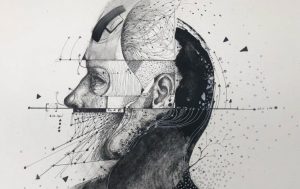Between the hours of 7 a.m. to 12:20 p.m., Tuesday through Friday, you will find a group of students at Los Angeles Trade Tech College painstakingly painting small black lines onto large sheets of butcher paper. It’s a unique and peculiar sight, unlike any other you will come upon at another college— and that’s because this is the only class of its kind in the country.
Welcome to LATTC’s famed Sign Graphics program, which has been taught at the college since 1924. It’s said that LATTC itself was founded around this course, and then expanded its class offerings from there.




I am a proud Sign Graphics student myself, currently in the third semester of a four-semester, two-year program. I enrolled in the fall of 2022, after becoming completely enamored by hand-painted signs when I moved to LA in 2016. I learned about the LATTC Sign Graphics program from sign painters I reached out to on Instagram, asking them how in the hell I could somehow do what they do. Each of their responses was the same:
If you want to be a sign painter, you have to take Sign Graphics at Trade Tech. That’s all there is to it.

It feels impossible to even attempt to express my Sign Graphics experience so far in a way that would do it justice, but I’ll give it a whirl. The rich legacy of the program emanates from the very many signs and letter charts adorning the walls of the classroom that have been painted by former students and instructors from years past. My instructors, Carlos Aguilar and Emmanuel Sevilla, are each Sign Graphics alums themselves, as Carlos took the course from 1995 to 1997 and Emmanuel did so from 2008 to 2010. Carlos first began teaching at Trade Tech in 2013 with the beloved instructor and bonafide sign painting legend Doc Guthrie. When Doc retired in 2021 after 30 years of heading the program, Carlos took over as lead teacher and Emmanuel joined him in 2022.


Most would consider taking an intensive class in which you dedicate 20 hours a week for two years to learning an old-world hand craft pretty ridiculous. But luckily, there is a steady wave of people just like me who are ridiculous enough to do it. The course attracts an eclectic group of people of different ages, ethnicities, races, socioeconomic statuses, and backgrounds, who share at least one thing in common: we’re obsessed with sign painting. Because you have to be obsessed to take this course— it’s not something you can do casually given the level of commitment required.

Many of the students I’ve met in my class have art backgrounds in other fields, and are looking to sign painting as an extension of what they already do. I spoke to three of them about their experience in Sign Graphics so far, how sign painting supplements their other art practices, and why the craft speaks to them so deeply. Nick Caruso, Heather Bleser, and Gabriel Rivera represent a microcosm of the diverse Sign Graphics student body, which is one of the things that makes the program so enriching.

Nick Caruso, Graphic Designer


Nick Caruso moved to LA from Pittsburgh when his wife’s career as a writer for television and film pulled them to Tinseltown. They uprooted their by-the-book lives in Pittsburgh for the thrill of LA uncertainty, selling their home and moving across the country with their two young daughters, diving headfirst into the unknown.
Nick has an extensive background working as a professional graphic designer for the last 20 years, designing across platforms including books, branding, exhibition design, posters, and apparel. He studied visual communications at Kent State University and bopped around New York City after that, ultimately landing at the publishing company Artisan where he designed book covers. When he moved from New York to his hometown of Pittsburgh, he began working for himself as a one-man design studio, where he collaborated often with sign painters for certain branding projects.


“I got to know all of the sign painters in Pittsburgh, and they were like, ‘Hey, we have this Pittsburgh Lettering Club, you should come by. We just hang out and drink beer and eat snacks,’” Nick told me. This was Nick’s first foray into the magical world of sign painting, with meetings hosted every other week at the studio of sign painter Andrew Paul, who helms Run Rabbit Gilding.
It was from this club that Nick learned of the LATTC Sign Graphics program. When Nick mentioned their move to LA, Andrew said, ‘So you know the first and last remaining program that teaches sign painting is in LA?’ It was a bug in my ear, and I started looking it up and figuring it out.” Nick officially enrolled in the Sign Graphics program soon after moving to the city, and a year later, he’s all in.
“I totally want to go on to work as a sign painter or actually have a sign shop or make my own products,” he said. “It’s low risk though, because if I leave this program and I’m not a sign painter, I still learned a ton about lettering, and lettering already goes hand in hand with the branding work I do. Even if I were to go back into books and book covers, I will be pulling from everything I’ve learned here.”

When I asked Nick what it is about sign painting that he loves so much, he said it’s the tactical process of an art form that’s done by hand. “I just really like building that skill set, and the repetitive nature of trying to get good at something. There’s no other way around it: you just have to put in the hours.” Nick acknowledges that while he has a degree in graphic design and decades of professional design experience under his belt, he’s by no means a sign expert just yet. “Swiss-influenced design was taught at the college that I went to, and I still hold on to all of that, but I have to kind of put it aside and check it at the door here, and not think that I know more, because I don’t! All of the rules and intuition and everything that I have has to be set aside and I have to listen.”
I just really like building that skill set, and the repetitive nature of trying to get good at something. There’s no other way around it: you just have to put in the hours.
Nick Caruso
As a non-native Angeleno like me, Nick has immense respect for the window into the real LA that Trade Tech and Sign Graphics offers. “It’s sort of awesome to be immersed in the culture of LA just by being in this room,” he said, and I couldn’t agree with him more. Many of our classmates and both of our instructors were born and raised right here in LA. There’s an authenticity and sense of being embedded in the city that comes with attending Trade Tech that is unique among other learning experiences.
Heather Bleser, Ceramicist and Leather Artist

Heather Bleser is an LA native and working artist who creates custom leather goods and pottery. She hand carves names and portraits into leather items within her brand Waste of Talent, and retouches hand-written recipes and love letters that she then glazes onto ceramics for the other arm of her artistic offerings, Soul Kitchen Keepsakes.
“All the things I do—the leather work and the pottery—are very hand done, and it’s all custom. I like the element of having something that’s one of a kind,” she said. “Whether it’s pottery or leather or signs, it’s all something that isn’t supposed to really be duplicated. Even if they’re the same, if they’re done by hand then each one is a little bit different.”
I like the element of having something that’s one of a kind.
Heather Bleser


Heather took a sign painting course in high school, but hadn’t pursued the craft any further until now, over 30 years later. “I just always wanted to do it; I wanted to just go up to a wall and be able to letter; not a lot of people can do that. I love seeing the way that old signs age, too. There’s a quality to it that you don’t get with other stuff. You can see there’s a personality and a human behind it.”
Heather, an insatiable learner, has taken art classes at colleges throughout LA for years, including at Otis College of Art and Design, ArtCenter College of Design, Pierce College, Cal State Northridge, and now LATTC. “I’ve taken a lot of classes here and there, and I still want to take more. Even with sign painting, there are those two-day workshops, and even though we’re going through this program, I’d love to see somebody else’s take on it.” This mentality reverberates throughout the sign graphics program, composed of creatives who are hungry to learn as much as possible. “I’ve taken classes at really good schools, but I don’t feel like Oh, I know it all!, and I’m 51 years old,” she went on. “You can get something out of any class you take if you’re interested. And it keeps you motivated! It’s cool being around other people, like our classmates, who get excited to go to school.”

Like me, Heather finds the diversity of Sign Graphics to be limitlessly inspiring and the fabric of what makes the course so meaningful. “Think about me, you, Gabriel, Nick, Val, Carlos, Jose— it’s a group of people at such totally different stages in their lives and from such different walks of life,” she said. “It’s interesting that everyone’s here for the same reason: because they all have a respect for handmade stuff.”
Gabriel Rivera, Tattoo Artist


There are strong ties between the worlds of tattooing and sign painting. Many tattoo parlors are adorned in hand-painted details, whether in the form of small internal signage or extravagant gold-gilded windows. At their core, tattooing and sign painting are similar handcrafts, each requiring meticulousness, attention to detail, and a steady hand, with many tattoo artists having dabbled in sign painting to hone their lettering skills. My classmate Gabriel Rivera represents this sect of the sign painting community, as a prolific tattoo artist at Greyscale Tattoo Studio in Anaheim.
The LATTC Sign Graphics course had been on Gabriel’s radar for years, after learning about it from many of the artists he admires. “I used to look up to pinstripers, and it turned out a lot of them had a sign painting background; it’s all tied into the family,” he said. “I found out that some of the tattooers and lettering guys that I looked up to took this course when they were very young. There was a crazy history, and these guys are super successful now; Mister Cartoon, OG Abel, Big Sleeps. I knew very early that this was the spot.”


Type-driven designs are central to Gabriel’s tattoo practice, so enhancing his lettering skills was one of the major motivators for his taking the course. Halfway through the program, he says the skills he’s learned so far have translated into his tattoo work. “I definitely pay a lot more attention to thick and thins, design layouts. Layout is one of the biggest things that helps. In the past I would cram things too much and I wasn’t thinking about spacing and margins.”
Gabriel also said that the lettering styles of tattooers with sign painting backgrounds are a cut above. “In tattooing, everybody seems to do script and old English, those are the go-to letters. Yes, that’s fun, and I do a lot of that and I love doing it, but it’s not enough. The way sign painters design is on another level, and I want to take that into the tattoo world. It’s something you don’t see as much, at least on the West Coast. You see it in Europe; in Europe they’re crushing letters in a different way where it’s more sign-painter-like. I would like to bring that style here. I want to learn as much as I can and maximize my skills in order to get better.”

Aside from using sign painting skills to better his tattooing, Gabriel is keen on learning another craft that he can add to his creative arsenal to supplement his tattoo practice. “I basically want to have other things in the wheelhouse so I don’t have to be tattooing six days,” he said. “I really love seeing things from beginning to end. It’s always a puzzle and it’s satisfying. Sign painting reminds me a little bit of tattooing or any lettering that I’ve done in the past; you’re on a mission and it’s so satisfying to see the whole thing.”
Sign painting reminds me a little bit of tattooing or any lettering that I’ve done in the past; you’re on a mission and it’s so satisfying to see the whole thing.
Gabriel Rivera

Each of us who completes the Sign Graphics program will come away with far more than sign painting prowess. Sure, we’ll have the fundamental rules of emphasis and margin spacing seared into our brains, and we’ll be able to instinctively pull a crisp enamel line on glass, but it’s the intangibles of the course that really make it tick, which are emblematic of the trade as a whole. What’s meaningful to me is the types of people attracted to an esoteric craft that most others would dub obsolete. People who are not only willing to dedicate so much of themselves to this skill, but consider doing so a privilege.
Carlos often repeats an old Doc adage in class: “It’s only a fucking sign.” This might be true, but Sign Graphics is much more than just a fucking class.



Learn more about LATTC’s Sign Graphics program.



